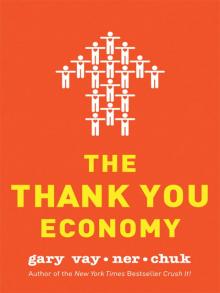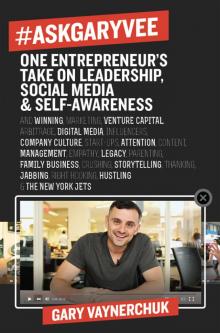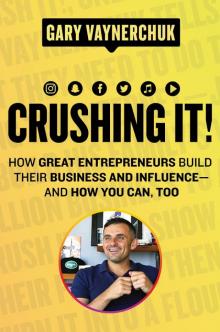- Home
- Gary Vaynerchuk
Jab, Jab, Jab, Right Hook Page 7
Jab, Jab, Jab, Right Hook Read online
Page 7
Poorly placed call to action: In addition, they placed their call to action—the link to the article—at the bottom of that big paragraph of text. Why would they? Less text would have highlighted the fact that Forbes wrote such a complimentary article instead of burying it.
No logo: As gorgeous as the car is, there’s no way to know who made it unless you think to look at the post’s profile picture. It wouldn’t have sacrificed any class or sophistication to make sure the Mercedes-Benz logo was tastefully inserted somewhere on the photo itself.
SUBARU: Amateur Night
There is so much to dislike about this piece of content it’s hard to know where to start.
Boring text: Like Mercedes-Benz, Subaru posted this piece to share a great review of their new car. But whereas Mercedes-Benz talked too much, Subaru has said too little. The copy length is ideal, but there was no reason to skip the opportunity to hint that the review was a positive one. What’s the big secret? They’ve missed a chance to get the fans excited and make them want to read more.
Terrible photo: Unless Subaru intended to sell pavement along with its cars, there is no reason why a wet road should dominate the entire lower half of the photograph. The Subaru is so far away it’s almost reduced to the same size as the little sailboats bobbing in the background.
No logo: There’s no reason for anyone to take notice of this photograph, but even if it did somehow register, without a logo there is nothing to explain to people why this car deserves attention.
While nothing could turn this pig’s ear into a silk purse, simply adding the Consumer Reports headline, a logo, and cropping the photo differently might turn this wasted opportunity into a serviceable jab.
VICTORIA’S SECRET: Fluent in the Platform’s Language
With this powerful right hook, Victoria’s Secret shows that they are fluent in native content–ese:
Dramatic photo: Obviously it’s not just the wings this model is sporting that are going to get people—men who love what she’s showing, and women who wish they had what she’s showing—to screech to a halt in midscroll. But Victoria’s Secret made sure that the design of the photo was as captivating as its subject. The image is big and bold enough to swallow up both a PC screen and a mobile screen; the minimalist black-and-white adds drama; the hot pink script overlaid against the model’s wings is as eye-popping as her cleavage and the lingerie enhancing it. They did everything they could to make sure that no one could miss this picture if it came into their News Feed.
Good use of copy: The text in the photo was placed close to the center, so that even if the picture were cropped because of a small mobile screen, the text would remain visible. The voice of the status update is pitch perfect, as is the length. The copy is short and direct, but that line in parentheses delivers it with a little wink, which adds the dollop of personality and humor that is so necessary to any brand’s social efforts.
Appropriate links: After the words “Apply here,” Victoria’s Secret attaches a link that takes you directly to the page where you can register for an Angel Card, making it easy and fast to make the sale. Is such a self-evident move really worth praise? You’d be amazed at how many brands set up a beautiful right hook, and then link to their general website, leaving customers fumbling around as they hunt for the appropriate tab so they can make their purchase. For an example, see the Lacoste tweet on page 96.
MINI COOPER: Inspiring a Spirit of Adventure
Great voice: I love the voice in this piece. In two lines, the status update promises that if you stick with Mini, you’ll find adventure. You could be in Switzerland! Driving through the snow! In a convertible! The idea of driving with the top down through snow is so absurd, it’s almost impossible to resist clicking on the attached link to find out how Mini could act like this drive was the trip of a lifetime. And the line “Wrap up warm” adds to our curiosity by hinting that whatever lies behind that link will put to rest any doubts we might have as to how comfortable the experience could be. Once you go to the blog post, which documents how all it takes is a pair of snow goggles and Mini’s heated leather seats to make an open-air alpine drive as comfortable as a road trip down California’s Highway 1, you’re sold.
Lacks a logo: I’ll forgive Mini for neglecting to include a logo on the photograph it used for this Facebook piece because the Mini is an iconic car, recognizable even when photographed from the back, as in this image. Still, I hope someone at the company reads this book and picks up the tip about including the logo on your micro-content, because if they start doing that their jabs will leave little to criticize.
Well played, Mini.
ZARA: Bait and Switch
With 19 million fans, Zara is a Facebook powerhouse. Why it chose to fail those fans so badly with this useless post is incomprehensible. Let’s dissect why it is a complete waste of the brand’s and its fans’ time.
Poor mobile optimization: I had to literally squint to read the fine print underneath the headline accompanying the photos. And what the hell are those two little squiggles under the iPhone? It’s even hard to make out that that yellow square is a sticky-note pad without bending your face closer to your screen. And that’s when the post is viewed on a laptop! The image would have been almost impossible to see on a mobile device.
Good copy: At least they got the copy right. “Just Apps” is short and sweet and tells you everything you need to know, which is that Zara has apps. Great. Where do I get me some? Ah, a link! I’m going to click on it. Now I can . . . shop on the Zara official home page. But I wanted to download an app! Isn’t that what you just announced, your apps? What the hell, Zara?
The more a brand posts links to sites that don’t bring value to their customers, the more hesitant fans are going to be to click any links they see from that brand in the future. This Facebook post is a short-term fail for letting its fans down with a bait-and-switch post, and a potentially long-term fail for jeopardizing the respect and equity Zara has earned within its community.
REGAL CINEMAS: Leveraging Their Brand
No industry has a better stable of iconic images with which to leverage their brand than the film industry. Yet not long ago I was analyzing a lot of movie theaters’ Facebook pages because I was considering some social media marketing opportunities, and at the time it was almost impossible to find a movie theater that used their status updates for anything other than pushing ticket purchases on Fandango. Regal Cinemas, however, bucked the trend with this successful jab that pits two movie characters against each other.
The picture: The theater’s marketing creatives probably sifted through thousands of pictures of each of these movie characters before deciding which ones to use, and they chose well. Even though Thornton Melon and Frank the Tank went back to school in films made almost twenty years apart, they’re clearly steeped in the same frat DNA.
The copy: For once, the status update for this content doesn’t repeat the copy in the artwork. Instead, the headline of the picture sets up the question, and the status update reminds us of the characters’ names, just in case someone out there isn’t familiar with them. And yet, at the risk of repeating itself, the company could have seen even better engagement had they listed the names of each character under their photo, or at worst simply labeled them “A” or “B.” Rule of thumb: Make it as easy as possible for your fans to engage! Why take the risk that someone won’t be able to come up with the characters’ names right away and therefore lose the opportunity to engage with them?
Yet again, no logo: Good for Regal Cinemas for remembering to build brand equity, but they would have been better off using a logo than a banner across the bottom of the art. Few people are going to type out the movie theater’s URL, so a better use of their limited space would have been to include a sizable logo in the corner. But that’s a minor criticism.
Very on point, Regal Cinemas. I’m happy with you.
PHILIPPINE AIRLINES: Totally Unappetizing
People love to talk about food,
so Philippine Airlines, which flies to lots of exotic destinations, had a good idea when it decided to ask its fans to describe their most exotic meal. But after having such a good idea, why did the company waste it?
Poor use of the platform: It should go without saying that if you’re going to talk about food, and you have the option to post a photograph, you should post the damn photograph. Philippine Airlines could have posted a gorgeous photo of a sublime Asian dish, or approached the concept with humor by photographing a plate of testicles or some other exotic dish—to Western palates, anyway—on an airline tray. It would have taken little effort to turn this content into something beautiful or fun.
Toneless: With airplane food the butt of so many jokes, they couldn’t come up with a way to imply that Philippine Airlines knows a little bit about great food? This status update is so bland and vacuous, any company in the world could have posted it. The company simply made no attempt to make the question relevant to Philippine Airlines or its customers.
Too many call-to-actions: Finally, Philippine Airlines needs to remember that less is more. Doubling the number of calls to action made it more challenging to get people to answer the questions. It seems crazy, but when people are moving through the stream as fast as they do now, two questions are too much. They should have been listed as two separate posts.
SELENA GOMEZ: A Golden Touch
Your phone and your fingers are together all the time, so why shouldn’t they complement each other? No wonder the hot new women’s fashion trend is to match your manicure to your phone case. Here Selena Gomez laughs at herself for jumping on the fad in this savvy jab (the phone and the manicure reflect the same warm gold as Selena’s promotional poster for her Stars Dance world tour), all while proving that she can carry it off to literally dazzling effect.
The photo: It’s big and bold, very native to the Facebook platform. With Selena’s glittery hand and phone swallowing up the camera, the picture would have been unmissable as fans scrolled through their news streams.
The copy: Celebrities are some of the worst social media abusers, and one of their biggest offenses is that they usually talk too much. Selena doesn’t, and with this status update she was smart enough to keep her text short and playful.
Shared more than 6,000 times and earning more than 220,000 likes, this sponsored story with Selena Gomez shows how far fans are willing to carry a brand’s content when you make them feel like everything you do is just for them.
SHAKIRA: Falling Flat
Shakira rolls deep with 63 million fans, and with this post does each and every one of them, as well as herself, a disservice.
Wrong type of post: Remember how Selena’s photo exploded into your line of vision? This one you have to squint to see, because it’s a link post, not a photo post. When you attach YouTube links, the fill-out—the headline, link, and text—share as much space as the photo, minimizing the photo’s effectiveness.
Poor photo: Not that this photo would have been particularly effective had it been any larger. The point of the post is to promote Shakira’s new perfume. So why are we seeing an image of her posing with a fan and a signed soccer jersey at a podium? It’s great to show how comfortable and generous Shakira is with her fans, but this is the wrong image for the purpose of this content.
The copy: First there’s the copy in English. Then there’s the copy in Spanish. And then there’s the description in the YouTube fill-out. This isn’t a novel, it’s a status update, and it’s supposed to be short. Brands have always been able to post according to language and location, so there was no need to double up on languages in this post. Especially when the content is so uninspiring. It’s strange that a woman with such a sizzling hot brand would post text with so little pizzazz.
No engagement: In addition, with the exception of one shout-out to her fans to thank them for liking her new Facebook page, there’s no engagement between the star and her fans. That seems like a strange choice for someone who wants people to buy her perfume.
The video: It’s six minutes long. No one in a Facebook mobile world has time to watch a six-minute video about your new perfume, no matter how much we like you.
The whole package, if you can stand to sit through the entire length of it, is supposed to give us a peek into the whirlwind life of a star, while revealing her humanity. There are many ways that Shakira’s team could have accomplished this while bringing value to her fans.
LIL WAYNE: Welcome to Spam City, USA
There is no other way to start this review than to congratulate Lil Wayne for becoming the first person to successfully turn Facebook into Myspace.
Poor page management: Allowing people to use your fan page to build up their own businesses and Facebook pages is an insult to all the core fans who come here to be a part of your community. In addition, you risk turning those fans into antifans, as evidenced by the comments speaking up in irritation “Ok, Lil Wayne, we get it, you posted this eight times. . . .” That individual is in for a long wait if he’s hoping for a direct reply, though—Weezy doesn’t come here. Ever. His neglect in managing his page, cleaning out the spam, and engaging with people implies that he really doesn’t care about his fans, and creates little reason for his fans to care in return, or to come back to his Facebook page.
It’s tough for me to make fun of Weezy because I love his music, but honestly, when you put this little effort into your social media promotion, you’re no better than the amateurs sticking promo fliers under people’s windshield wipers.
MOSCOT: Possibly the Most Confusing Facebook Post Ever
Normally, this small American business puts in a solid performance on Facebook, but this post, highlighting a positive review of the brand on an Israeli website, reveals a number of key mistakes.
Text, text, and more problems with text: First, there’s the double copy supporting the photograph of Johnny Depp, in Hebrew and in English (though it takes some effort to find the English text). Facebook is not the place to be flooding fans with text.
Indecipherable text: Second, the copy that does hit us in the face is in Hebrew. It’s kind of arresting, and when combined with the photo of Johnny Depp may be enough to make readers stop in their tracks. But not for long. As soon as most fans realize that they can’t read anything on the page—this is an American company, and most fans will be American—they’re going to move on. Few will hunt beneath the brand’s tiny profile picture and click on “See More,” where they will be rewarded with the English translation of the article. Last, whether in Hebrew or in English, no one should ever post copy more than a thousand words long on Facebook.
One more thing. Here and all over their Facebook page, Moscot likes its own posts. That’s lamezor, Moscot. Please stop.
UNICEF: Giving Away Too Much, Too Soon
This celebrity-based post is another example of how ignoring the small nuances of a platform can make or break your content.
Good imagery: UNICEF did a lot right here. They had their finger on the pop culture pulse and chose the right celebrity with the ever-popular Katy Perry. The picture of a smiling Katy jumping rope with some village girls in her UNICEF T-shirt is spot-on, and should work well to bring awareness to the brand.
Botched copy: Where they goofed is in the copy. The first line is “Want to know what Katy Perry has been up to?” Good question. Provocative. Engaging. And UNICEF blew it by offering the answer.
The post should have ended with that first line, punctuated with a link. Leaving the question hanging would have whetted visitors’ appetites for more, and kept them intrigued enough to follow UNICEF’s digital bread crumbs to their website, where they could have elaborated on their humanitarian work in Madagascar and other countries. Serving up the answer right away robbed the post of all its energy and style.
It’s a near miss—just one little tweak and this jab would have hit its mark.
LAND ROVER: Going Nowhere
I wanted to destroy this Land Rover post the first time I saw it,
but as I looked under the hood, I started to wonder whether the problems plaguing this content were caused by a lack of corporate support for a creative team’s honest efforts.
No brand ID: Don’t get me wrong, the execution is weird. Imagine this coming through your stream. You see a woman peering through a telescope at you, but with no logo and no prominently overlaid text, there’s no way to know what it’s about unless you pause to squint at the text below.
Wrong URL: There, we see the post is from Land Rover, and that they’ve got something special planned and they’d like us to send in a passport-style photo to [email protected]. They did a good job of keeping the text short and to the point, but then they made a surprisingly ghetto choice. Why didn’t Land Rover secure a .landrover email address instead of a Gmail address? In addition, one can only hope that they aren’t strict with their definition of “passport-style,” because the photo they used, with half the woman’s head blocked by a telescope, is not passport-style. Maybe that doesn’t matter, though, because when we click through the link that takes us to a page where we can read more about the project, they don’t reiterate the passport-style requirement.
Go-nowhere link: This error in consistency is minor, however, compared with the fact that the link takes us from the company’s Facebook post . . . straight to another company Facebook post. This tells me that the creative team wasn’t given the proper financial or managerial support to execute this project correctly with a proper website.

 The Thank You Economy
The Thank You Economy Crush It!
Crush It! #AskGaryVee
#AskGaryVee Crushing It! EPB
Crushing It! EPB Jab, Jab, Jab, Right Hook
Jab, Jab, Jab, Right Hook